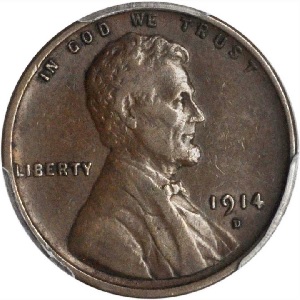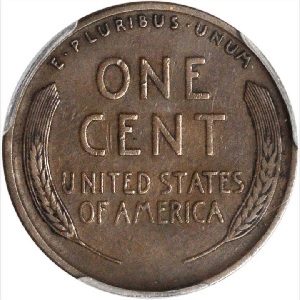1914-D Lincoln Cent
As the coin presses in Denver ceased production of the one cent coin in 1914, no one regarded the 1914-D Lincoln cent as a rarity. There was no publicity or controversy stoking interest as had occurred with the release of the 1909-S VDB cent.(1)
Consequently, most of the 1.2 million mintage (very small by 20th century standards) entered circulation, where they acquired heavy wear or became lost forever.(2)
By the 1930s, coin boards became the rave for hobbyists to display their collections. The empty slot for the 1914-D on most boards was visual evidence of the scarcity of this date.(3)
In 1936, the numismatic circular, Raymond's Standard Catalogue of United States Coins and Currency, estimated the value of the 1914-D at $2.50, the highest of any Lincoln cent, including the 1909-S VDB, which they listed at 50 cents.(4)
When the popularity of Lincoln cent collecting soared in the 1950s and 60s, the 1914-D became one of the most sought-after coin in numismatics. Prices rose accordingly.(5)
With fame and popularity came problems. Alteration fraudsters and counterfeiters took advantage of inexperienced collectors in their zeal to add a 1914-D to their coin albums, unloading thousands of fakes onto the market. Some experts believe there may be more phony 1914-D Lincolns in existence than authentic examples.
Over the decades, this has not dampened enthusiasm for the 1914-D. It, along with the 1909-S VDB, 1922 "Plain", and the 1955 Double Die, form the key date “Grand Slam” of Lincoln cents (some include the 1931-S in that elite group as well).
If there has ever been a coin that moves in predictable patterns, it is the 1914-D. Prices peaked in 1965, 1985, and again in 2008-09. So, the data suggests it takes 20-23 years to complete a cycle. At the moment, we are at or near the bottom of the current cycle. Just sayin’…
| Estimated survivors in all grades: 122,500 ?
The survivor estimate from PCGS represents an average of one or more experts' opinions as to how many examples survive of a particular coin in all grades. Survival estimates include coins that are raw, certified by PCGS, and certified by other grading services. Learn more at PCGS. |
| PCGS Rarity Scale: 1.9 ?
The 'PCGS CoinFacts Rarity Scale' assesses the relative rarity of all U.S. coins, based on estimated surviving examples. The scale runs from 1.0 to 10.0. The higher the number, the rarer the coin.
Learn more at PCGS. |
| Click HERE to check for availability on eBay** |
Preview of eBay selection:
 |
 |
| Trendline Avg = 4.90 | CLASSIC RARITY |
Historic Value Trend Charts:
| Last updated 11-11-24 | Return to Key Date Coin List | |
| Compare to Common Date Coin of Same Type | ||
|
|
||
| Download Charts to Your Computer | ||
Sources
1. Heritage Auctions. 1914-D 1C. Jan 2019 Auction.
2. Stack's Bowers Galleries. 1914-D Lincoln Cent. Mar 2020 Auction.
3. Heritage Auctions. 1914-D 1C. Jan 2019 Auction.
4. Heritage Auctions. 1914-D 1C. Jan 2007 Auction.
5. Heritage Auctions. 1914-D 1C. Mar 2005 Auction.
**Many very fine coin dealers sell on eBay. At any point in time, there may be over one million search results for United States coins. This includes quite a few of the recommendations on our Key Date Coin List.
If you’re thinking about purchasing a rare coin, eBay is certainly worth a look. For your convenience, the links from this site to eBay are coded to bring up only coins certified by PCGS and NGC.
As is always, always the case, never buy a valuable coin from a seller whose trustworthiness cannot be verified. Learn more about this at our chapter Best Places to Buy Coins, which also has a section on doing business on eBay.
In the interest of full disclosure, Rare Coins 101 receives a small commission anytime someone connects to eBay from this site and purchases something.
Coin images by Stack's Bowers Galleries.


